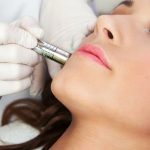What is microdermabrasion?
Microdermabrasion is a cosmetic procedure. It involves a skin care specialist removing the top layer of skin with a small hand-held device.
Microdermabrasion can exfoliate the skin, reduce signs of aging, and make the skin appear more even. The procedure is safe a person with any skin color. Microdermabrasion is a noninvasive cosmetic procedure. The specialist sprays or rubs fine crystals onto the skin with a wand that gently exfoliates the surface, removing the top layer. The aim is to make the skin appear younger.
The procedure should not be painful. The American Academy of Dermatology (AAD) estimate that it takes 20-30 minutes for the face and 20 minutes for the neck. Afterward, there may be slight swelling or sunburn-like symptoms for a few days.Before seeing reduced signs of aging, a person may require between 5and 16 treatments from a skin care specialist.People can have treatments weekly, every 2 weeks, or monthly, depending on their skin type and the reason for treatment.Most people request microdermabrasion to rejuvenate the complexion of the face and neck, but a specialist can perform the procedure on any area of skin.The results are not permanent.
Uses and benefits:
The goal of microdermabrasion is to make a person’s complexion smoother, brighter, and more even in color.
People often request microdermabrasion to address:
- dullness in the complexion
- uneven skin tone such as vitiligo
- uneven skin texture
- age spots
- dark spots that can form after acne clears up
- melasma, a common issue that forms dark spots or patches on the skin
- scars
Dermatologists may also use microdermabrasion to enhance the results of anti-aging or skin-bleaching products. The procedure can help these products penetrate the skin and also A dermatologist may recommend dermabrasion for acne scars, scars from accidents or surgery, or to remove tattoos.Dermabrasion is only suitable for people with fair skin. Microdermabrasion can be suitable for people with any skin color.
Risks and side effects of microdermabrasion:
People who have taken the acne medicine isotretinoin in the past 6 months may need to wait before having microdermabrasion. They have an increased risk of complications such as scarring.
Speak to a doctor about any spot or patch of skin that is growing, bleeding, or changing in any way. These issues can indicate skin cancer .
For a few days after microdermabrasion, a person may notice:
- skin swelling
- skin redness, similar to sunburn
- bruising
- a burning or stinging sensation
- increased sensitivity of the skin to sunlight
After the procedure, use sun protection. This will help to ensure the best results and reduce the risk of side effects. Microdermabrasion may not be suitable for people who scar easily or have cold sore breakouts.
Unallowed for using microdermabrasion:
- People who have herpes or warts on their face.
- People who have had facial surgery in the last 2 months.
- People with deep wounds, active colloids, immune system disorders or diabetes.
- Pregnant women should not have microdermabrasion.
- Patients taking oral isotretinoin during treatment.
- People who have neck radiotherapy.
- Microdermabrasion is also not suitable for people who have had eczema or psoriasis in the last 12 months.
What are the appropriate intervals and number of microdermabrasion sessions ?
- In general, depending on the type of client’s problem and the doctor’s diagnosis, the interval sessions is from 1 to 4 weeks , for rejuvenation and from 4 to 6 sessions and 10-12 sessions for removing blemishes and lighten the skin respectively .
Pre – Microdermabrasion Instructions:
- treatment.
- Avoid sun tanning or tanning creams/sprays for at least a week before treatment
- You must NOT have recently had laser surgery or used Accutane
- Candidates who have had a recent chemical peel or other skin procedure, such as collagen injections , should wait two to three weeks before undergoing microdermabrasion.
- Prospective patients should also refrain from waxing or tanning the skin to be treated for a few weeks prior to microdermabrasion treatment.
- Wash your face and neck with a non-oily, non-soap based cleanser before each scheduled treatment.
Post – Microdermabrasion Instructions:
To maximize microdermabrasion recovery time and results, it is important to follow all post-procedure instruction below:
- Keep the new skin clean and moisturized
- Anti-inflammatory creams or cold compresses may be used as necessary
- Use a gentle cleanser.
- Trauma such as scratching or picking the treated area should be avoided.
- It is important to avoid irritatig the treated skin with harsh chemicals, rubbing or tanning for one week.
- Although some peeling may occur in the treated areas, moisturizer should help minimize this effect.
- Avoid staying in the sun for at least 7 days after the microdermabrasion treatment to prevent UV rays from damaging your skin which slows down the recovery.
- Patients who absolutely cannot avoid sun exposure should use a broad-spectrum sunscreen with an SPF of 30 or higher.
- Do not use glycolic, alpha hydroxy, beta hydroxy, retinol, benzyl peroxide or topical acne medicatios for 24-48 hours following treatment.
- You may resume prescription retinoid products (Retin A, Renova, Tretinoin, Avita, Alustra or other brands f Tretinoin and other prescription retinoid products (Adapalene, Avage, Differin, Tazorac, Tazarotene) 3 – 7 days after last microdermabrasion treatment or as instructed by your technician.
If you are receiving a series of treatments, do not resume any of these products until after you have completed your last medical microdermabrasion treatment.
